Feral Pet Amphibians and Reptiles in California
Be a Responsible Pet OwnerDON'T LET IT LOOSE, CALIFORNIA! - CDFW

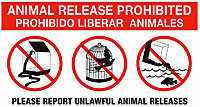 |
| Report an Invasive Species Sighting to the California Department of Fish and Wildlife |

| This is a list of common, mostly non-native, pet amphibians and reptiles which I have learned have been found in the wild in California, but which are not on my list of Established Non-Native Species of Amphibians and Reptiles in California because they are not necessarily part of an established breeding group. (Some are established, most are not yet established.) There are certainly many more species of which I am not aware. Most of these feral pets have been found in well-populated residential areas where herps are commonly kept as pets. In most cases it is not possible to know if the pets were abandoned or if they escaped. Some have been found in public open space areas not near populated areas, which most likely indicates abandonment by irresponsible owners. Feral native species kept as pets have also been found released into the wild, but these are harder to discover unless they are found where they should not occur, or unless an unusual variant created in the pet trade is found in the wild. So far I have only learned about the native California Kingsnake and the native Mohave Desert Tortoise occurring where they should not, but there are likely more native species of pets abandoned in the wild. I cannot cover every species of amphibian and reptile that is commonly kept as a pet in California, because nearly any pet herp can escape or be abandoned, but if you think I am missing an important one, let me know. Many of those shown here were reported to me by users of this web site who found an animal in their yard and asked me to identify it for them. The pet trade in herps is booming and unless fewer herps are purchased by more responsible pet owners there will be many more abandoned and escaped herps found in the state. This could lead to more non-native herp species established in the state. While it's interesting to keep track of them as I am doing here, it is never good for our native wildlife when non-native species take hold in their habitat and compete with them, and it is often fatal for animals abandoned in unfamiliar habitat where they struggle to survive. So far no imported pet trade snakes have been found to be breeding and forming populations in the wild in California besides the watersnakes, but there are several species of frogs and lizards that have, with an increasing number of exotic geckos becoming established, mostly in southern California. Many of these have spread through transport, not abandonment. If you find a pet herp in the wild in California, l'd like to hear about it and add it to this list if it's not already here. If you have pictures of animals on this list that have been found in the wild that are not illustrated here, please email them to me so I can use them here. If you capture an exotic herp in the wild and want to find out what you can do with it, try contacting a local pet organization, herp society or pet rescue organization to find out if they can find someone to adopt it. Some veterinarians who work with exotic pets may also be a good source of information. Anapsid.org maintains a great list of herp societies and amphibian and reptile rescue organizations. Preventing Invasive Species Introductions - California Department of Fish and Wildlife |
||||||||
Lizards |
||||||||
| Bearded Dragon - genus Pogona | ||||||||
| Several species of this lizard, originally from Australia, are common pets. They have been bred in a number of different color variations. I have received several reports of them found in yards, sometimes after they were killed by the family dog, including a few shown below. |
||||||||
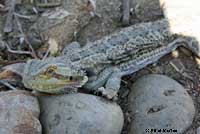 |
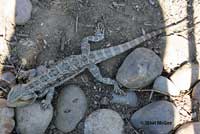 |
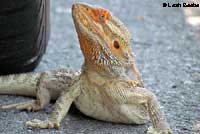 |
||||||
| This bearded dragon was found in a San Diego County yard after somebody cleared some brush. © Edith McGee | This bearded dragon was found outside a house in Redondo Beach. © Leah Beebe |
|||||||
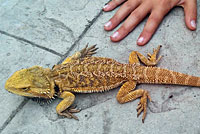 |
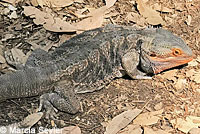 |
 |
||||||
| This bearded dragon was found in a back yard in San Diego |
This adult Bearded Dragon was photographed as it was lying on a hiking trail in San Mateo County where it was most likely abandoned by an irresponsible pet owner. © Marcia Seyler | Captive adult | ||||||
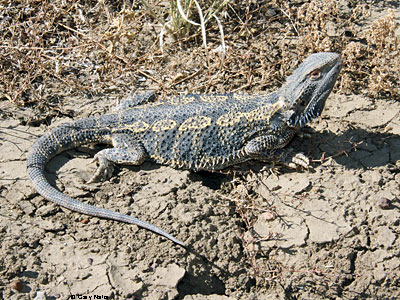 |
||||||||
| Wild adult in its natural habitat, Queensland, Australia |
||||||||
| Spiny-tailed Iguana - Ctenosaura hemilopha | ||||||||
Native to southern Baja California, Mexico. Sometimes found loose in the state. Juveniles are bright green.
|
||||||||
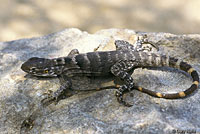 |
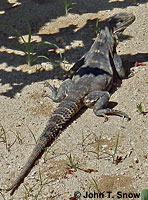 |
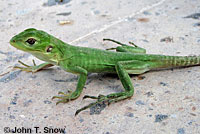 |
||||||
| © John T. Snow | © John T. Snow | |||||||
| Blue-tongued Skink - genus Tiliqua | ||||||||
| I have received a report that one of these large Australian lizards, sometimes available in pet stores, was found in someone's yard in California. |
||||||||
Monitor Lizards - genus Varanus |
||||||||
| I have received a few requests to identify various species of Monitor Lizards that were found in someone's yard or observed in the wild. Many monitor lizards are kept as pets, but some species grow to a very large size that can be difficult to maintain in captivity,
and for this reason they escape or they are released into the wild illegally. Some species in the pet trade include: Savanna Monitor - Varanus exanthematicus, Nile Monitor - Varanus niloticus, Water Monitor - Varanus salvator. |
||||||||
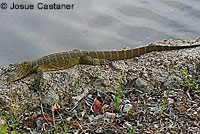 |
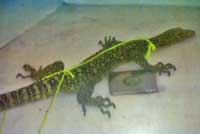 |
 |
||||||
| This monitor was observed basking at the edge of some water in Escondido, San Diego County © Josue Castaner | This monitor lizard was found abandoned and tied to a fence in Los Angeles County. © Cassandra |
|||||||
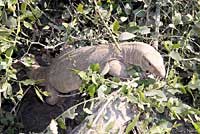 |
||||||||
| Wild Bengal Monitor lizard in India | ||||||||
Brown Anole - Anolis sagrei |
||||||||
| This species has been established in southern California and could be spreading to other locations. Since Brown Anoles are often purchased in pet stores not as pets, but to feed lizard-eating snakes, stray individuals escaped from the pet and pet food trade can be found in any populated areas. |
||||||||
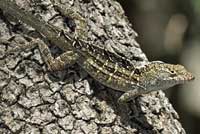 |
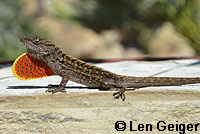 |
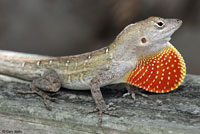 |
||||||
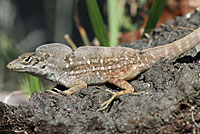 |
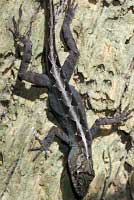 |
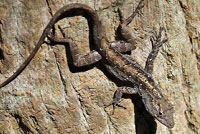 |
||||||
Green Anole - Anolis carolinensis |
||||||||
| Green Anoles are now established in many areas in Southern California. They are commonly found in pet stores sold as pets or as food for lizard-eating snakes, so they can show up in almost any populated area. |
||||||||
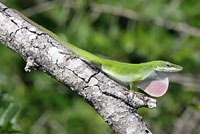 |
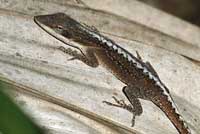 |
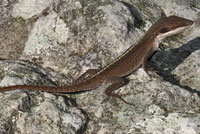 |
||||||
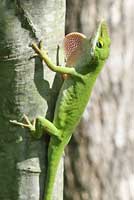 |
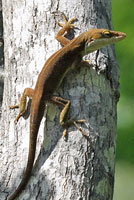 |
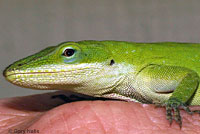 |
||||||
Green Iguana - Iguana iguana |
||||||||
| Native to Central and South America this lizard is a common pet that is sometimes found in the wild in California. They are well-established in South Florida. Adults grow to several feet in length. Juveniles are bright green. |
||||||||
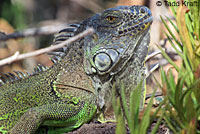 |
 |
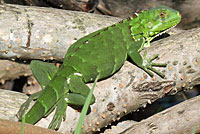 |
||||||
| Adult, found in a park in Orange County. © Tadd Kraft | This big adult male was found as seen here on a California country road far from any houses, so it was most likely abandoned by someone. Adults can grow very large and become difficult to care for. | Juvenile, Florida | ||||||
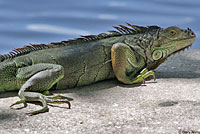 |
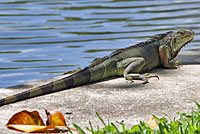 |
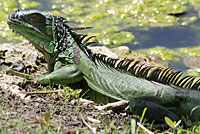 |
||||||
| Adult, Florida | Adult, Florida | |||||||
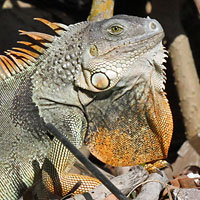 |
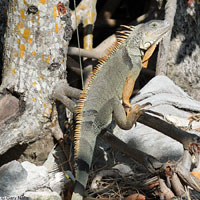 |
|||||||
| Adult, Florida | ||||||||
House Gecko - Hemidactylus spp. |
||||||||
| Various species of House Geckos are often seen for sale in pet stores. Any of them may turn up anywhere. Some have become established in southern California. They are typically seen on walls under lights at night eating small invertebrates that are attracted to the light. They are often purchased not as pets, but to feed lizard-eating snakes. Some pet stores are known to have thriving populations of the geckos roaming freely inside and out. There are many species which are not easy to tell apart.
The Common House Gecko and the Indo-Pacific House Gecko are both native to South and Southeast Asia and are known to be established in Florida, Texas, and Hawaii. There is also a species that has become established in Baja California, at least in the Cape Region, possibly elsewhere. |
||||||||
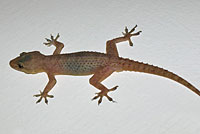 |
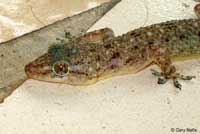 |
 |
||||||
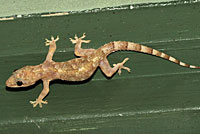 |
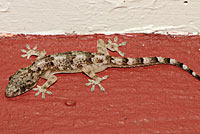 |
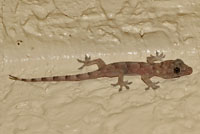 |
||||||
| Texas Horned Lizard - Phrynosoma cornutum | ||||||||
| This horned lizard is very similar in appearance to the California native Blainville's (Coast) Horned Lizard. It is occasionally kept as a pet and released when unwanted, probably because they are very difficult to maintain. It has become established in the east in a few locations. |
||||||||
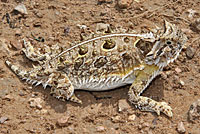 |
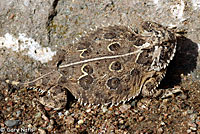 |
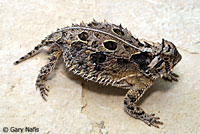 |
||||||
| Adult, New Mexico |
Adult, Arizona | Adult, Texas | ||||||
Wall Lizards - genus Podarcis |
||||||||
| One species of Wall Lizard, Podarcis siculus, has been established in southern California, and it is likely that more of these popular pet lizards have escaped or have been released in other areas of the state. (I have not been able yet to confirm a rumor that they have also been established in Pacifica, in San Mateo County.) Wall Lizards have also become established in several other states in the U.S.A. and on Vancouver Island and the Vancouver area of British Colombia. The lizards shown above are all from the San Pedro population established in Los Angeles County. |
||||||||
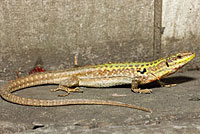 |
 |
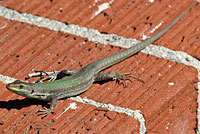 |
||||||
Veiled Chameleon - Chamaeleo calyptratus |
||||||||
| These chameleons are native to the southwestern Arabian Peninsula are are often kept as pets. Sometimes they get loose or they are abandoned in the wild. |
||||||||
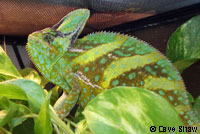 |
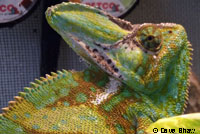 |
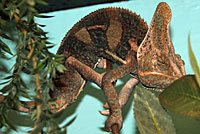 |
||||||
| The lizard above was found in San Diego County, where there may be an established population derived from escaped pets. © Dave Shaw | Captive adult | |||||||
| Jackson's Chameleon - Trioceros jacksonii | ||||||||
| Jackson's Chameleons are popular pets. There is at least one established population in Morro Bay, and they have been found in La Jolla, but they sometimes escape or are abandoned and are found in other areas. |
||||||||
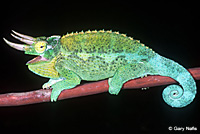 |
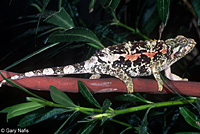 |
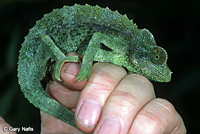 |
||||||
| Adult male (left) and adult female (center) from the Morro Bay population. | Adult female, Hawaii | |||||||
| Panther Chameleon - Furcifer pardalis | ||||||||
| This Madagascar native is a popular pet. Observations of individuals found in the wild in Los Angeles and San Diego Counties have been posted to iNaturalist, but it is unlikely that they have become established. An established population was documented in Florida in 2013 but in much different habitat than southern California. |  © John Sullivan |
|||||||
| Uromastyx or Spiny-Tailed Lizards (many species) | ||||||||
| Uromastyx are popular pets that originate in North Africa, the Middle East, and Iran. They are mostly herbivorous. |
||||||||
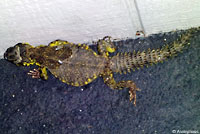 |
||||||||
| This Uromastyx was found in a yard in southern California. | ||||||||
| Beaded Lizard - Heloderma horridum | ||||||||
| This is a very large rough-skinned dangerously venomous lizard with huge claws that is related to the Gila Monster. I saw some for sale in pet stores in the '90s, but I don't know if buying and selling them is still legal in California. |
||||||||
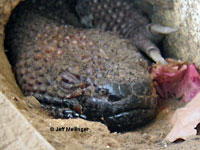 |
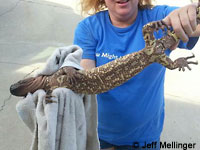 |
|||||||
| This adult male was found living in a hole next to some trash cans in the hills above Lake Elsinore. It was removed by an experienced reptile re-locator. © Jeff Mellinger | ||||||||
| Blue Spiny Lizard - Sceloporus cyanogenys (= Sceloporus serrifer cyanogenys) | ||||||||
| Native to southern Texas and northeastern Mexico and sold in pet shops. In his 1972 guide to California's herps, Robert Stebbins reported that they were found at the base of the Palms to Pines highway south of Palm Desert in Riverside County. Wikipedia Entry |
||||||||
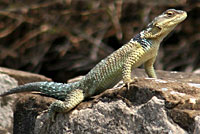 |
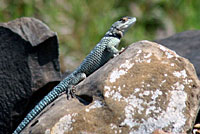 |
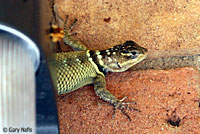 |
||||||
| Adults, Starr County, Texas | Adult, Hidalgo County, Texas | |||||||
| Common Leopard Gecko - Eublepharis macularius | ||||||||
| Leopard geckos are very common pets. A large gecko, measuring up to 11 inches in length (28cm), they are native to rocky areas in dry grassland and desert regions of Afghanistan, Pakistan, northwest India and parts of Iran. Sometimes released pets are found in the wild in California, though they have not been established anywhere yet that I know of. |
||||||||
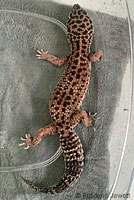 |
||||||||
| Adult, found in the wild in San Diego County. © Frederic Jewett |
||||||||
| European Glass Lizard (Sheltopusik) - Pseudapus apodus | ||||||||
| I don't have a picture of this species native from southern Europe to central Asia, but you can see one that was reported found on a road in southern California on iNaturalist and on Wikipedia. | ||||||||
Snakes |
||||||||
| Snakes are master escape artists and excellent climbers that can squeeze into small spaces. Anyone who has kept them will have an escape story. (A snake of mine once escaped into my garage in November. I found it in March after it returned to warm up next to the heating element on top of a lizard cage. Either that or it was trying to figure out how to get in the cage to eat the lizard.) So just about any species of snake kept as a pet could be found outside of its cage. Unfortunately, that includes exotic venomous snakes which are popular with some keepers. |
||||||||
Milk Snake - Lampropeltis triangulum |
||||||||
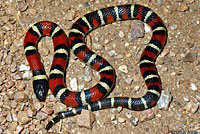 |
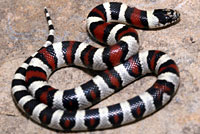 |
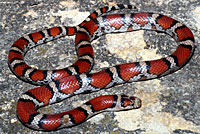 |
||||||
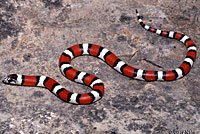 |
||||||||
| Milk snakes are common pets. I have received several reports of milk snakes found in yards, and one on a hiking trail. Unfortunately, this harmless snake is often mistaken for the venomous coral snake, which does not occur in California, and it is killed for no good reason. The snakes shown above are milk snakes that I photographed in the wild, but many snakes in the pet trade are from Mexico and Central America, and look much different from these. Milk snakes are highly variable in appearance. Most have black, white, and red, or orange, bands, but some lack the white bands. One common pet, the Sinaloan Milk Snake, has very wide orange bands. Albino milksnakes are popular in the pet trade and should also be expected to have been released into the wild. |
||||||||
California Kingsnake - Lampropeltis californiae |
||||||||
 |
||||||||
| California Kingsnakes are found in most of the state, but they are also very popular in the pet trade, and breeders have bred many different aberrant morphs not typically found in the wild. That makes it hard to know if a normal California Kingsnake found in an area easily accessed by humans is wild or a feral pet. While there are also many naturally-occurring aberrant morphs, they tend to be found mainly in coastal southern California and in the Central Valley, so when one of them is found where they normally are not found it can be assumed that the snake is a feral pet. The aberrant California Kingsnake shown above was observed in the Santa Monica Mountains in Ventura County, near a public parking lot, so it's not possible to know if it's a wild snake or an unwanted pet someone dumped in the wild. Albino kingsnakes are common in the pet trade, but this one has dark eyes so it is probably leucistic. © Mark Kroenke |
||||||||
Corn Snake - Elaphe guttata |
||||||||
| Corn snakes have been very common in the pet trade for many years. Corn snake breeders have created many different color and pattern variations for the pet trade including albinos, which are pink or orange. |
||||||||
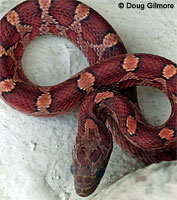 |
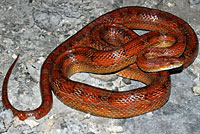 |
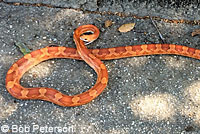 |
||||||
| This Corn Snake was found unexpectedly on an Encinitas front porch. It turned out to be the escaped pet of the boy next door. © Doug Gilmore |
Wild Corn Snake found in the Florida Keys. |
Albino Corn Snakes are popular pets that come in a variety of colors and patterns. This one was found in San Mateo County. © Bob Peterson | ||||||
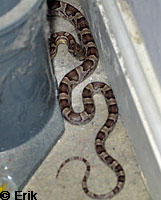 |
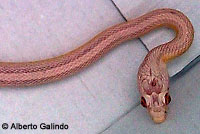 |
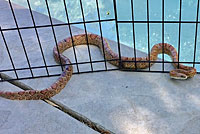 |
||||||
| This normally colored and patterned escaped Corn Snake was a big surprise when it was found in a bathroom inside a house in Santa Clara County. © Erik | This is the less-common striped variety of albino Corn Snake. It was found under some back yard bricks in San Diego County. © Alberto Galindo | This adult Corn Snake, seen lounging by a pool, has inhabited a Sacramento backyard for more than a year. | ||||||
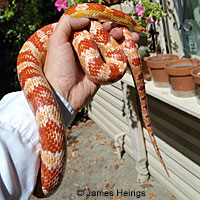 |
||||||||
| This albino designer Corn Snake was found under a bush in Placer County. © James Heirigs |
||||||||
Beauty Rat Snake - (Beauty Snake, Cave Racer) - Elaphe taeniura (Orthriophis taeniurus) |
||||||||
| I have received several reports of this species of snake seen in the wild in California in Ventura County and in Contra Costa County and have heard that it has also been seen in Santa Ana, along with the Chinese Rat Snake - Ptyas korros (aka Indo-Chinese Rat Snake.) Both beauty snakes shown to me in pictures were very large - probably 6 - 7 feet in length. The species grows up to 10 feet in length. This leads me to suspect that pet snakes are dumped into the wild after they grow too large to take care of, which is similar to the fate of many large pet snakes such as Burmese Pythons and Boa Constrictors, neither of which are established in California, but they are established in Florida. It appears that there have been a few snakes of this species in the wild in Contra Costa County. In 2015 I received a report of a Beauty Rat Snake that had been found dead on a road in Lafayette, Contra Costa County, a few years previously. In 2016, I received a report of a large Beauty Rat Snake that was seen in Pleasanton, Contra Costa County. I also received several reports of a snake in Lafayette over a four year period. |
||||||||
 |
 |
|||||||
| Photos © Gailene Nelson | ||||||||
The Lafayette Beauty Rat Snake The Beauty Rat Snake shown in pictures above was photographed in Lafayette, Contra Costa County. The picture on the left was taken in 2014. The picture on the right was taken in the same yard in March 2015. This snake found itself a nice niche and survived in the area for at least 5 years. In May 2015 I received another email about what was probably the same snake from a different person in the same neighborhood. In May 2018 I received another report with video from showing what was probably the same Beauty Rat Snake from the same area in Lafayette, one block away, including sightings of shed skins found in an attic, where it was apparently taking shelter. Finally in May 2019 I was told that a Beauty Rat Snake was captured in the exact same area in Lafayette. It was more than 10 feet long. A picture of that snake is shown below. Unless there is more than one full-grown Beauty Rat Snake in the same area, the captured snake is surely the same snake that has been observed since at least 2014, now back in captivity where an exotic pet snake belongs. |
||||||||
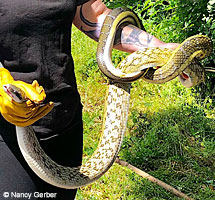 |
||||||||
| © Nancy Gerber | ||||||||
Chinese Rat Snake - (Indo-Chinese Rat Snake) - Pytas korros |
||||||||
| This semi-arboreal species is native to northern India, Burma, Thailand, Indochina, Malaysia, Singapore, and Indonesia. | ||||||||
 |
 |
|||||||
| Adult, Arunachal Pradesh, India © Ashok Captain | ||||||||
Ball Python - Python regius |
||||||||
| A small python with a docile temperament that rolls itself into a ball when it is threatened or stressed, the Ball Pythons is one of the most popular pet snakes. It's both captive bred and imported. The large number of them in captivity and their low energy requirements and ability to utilize various habitats give them a high potential to become an invasive species. |
||||||||
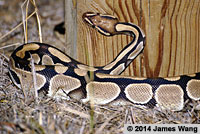 |
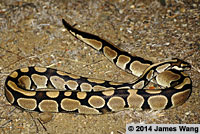 |
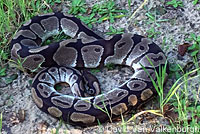 |
||||||
| Ball Python found abandoned in a Los Angeles County park. © James Wang | Ball Python found abandoned in Santa Maria, Santa Barbara County in February. © David Van Valkenburgh | |||||||
| These are very common in the pet trade. Like the Ball Python, they have a high potential to become an invasive species, but so far they have only become established near Miami, Florida. |
||||||||
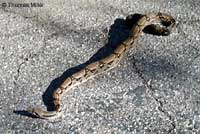 |
||||||||
| This escaped or released Boa Constrictor was found on a driveway in Ventura County. © Thomas Miller | ||||||||
Burmese Python - Python molurus bivittatus |
||||||||
| This popular pet has not become established in California, as it has been in south Florida, but escapees have been seen in California. Some pictures I have taken of the Indian subspecies and its habitat in the wild can be seen here. |
||||||||
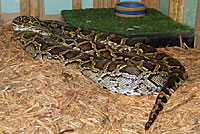 |
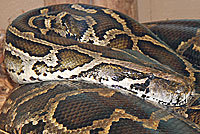 |
|||||||
| Large adult Burmese Python in a zoo | ||||||||
| Amethystine Python (Scrub Python) - Morelia kinghorni (or amethistina) | ||||||||
| Another popular pet python. |
||||||||
 |
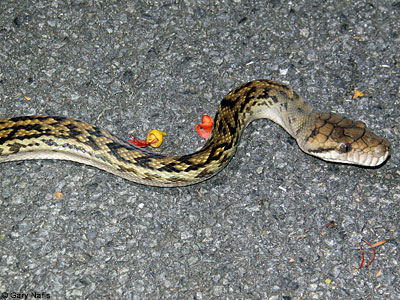 |
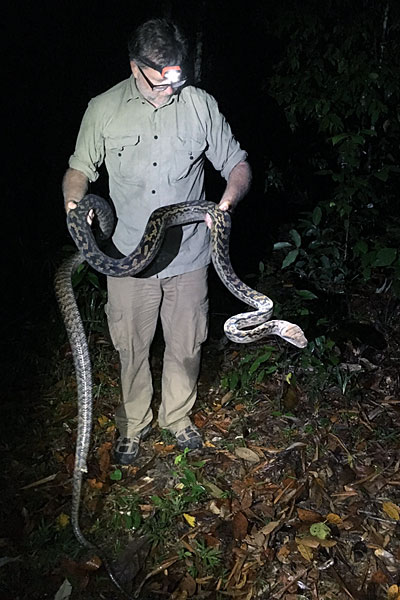 |
||||||
| Adult in the wild, Queensland Australia |
Juvenile in the wild, Queensland Australia |
Adult found at night in a rainforest in Queensland Australia |
||||||
Watersnakes - Genus Nerodia
Florida Watersnake - Nerodia fasciata Common Watersnake - Nerodia sipedon Diamond-backed Watersnake - Nerodia rhombifer rhombifer Not Native to California |
||||||||
|
It is unlawful to import, transport, or possess any Watersnakes of the genus Nerodia in California except under permit issued by the California Department of Fish and Wildlife. (California Code of Regulations, Title 14, Excerpts, Section 671) The California Watersnakes Site reports on news, publications, and sightings related to non-native watersnake species (Nerodia) in California. If you see a watersnake in the wild in California at a location not mentioned on the California Watersnakes Site, please report it to California Nerodia Watch at iNaturalist. (Don't confuse Watersnakes (Nerodia) with native California gartersnakes. Most gartersnakes have stripes on the sides and sometimes on the back. Watersnakes have no stripes.) |
||||||||
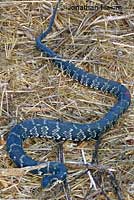 |
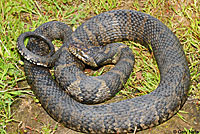 |
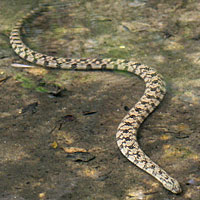 |
||||||
| Adult Florida Watersnake Los Angeles County © Jonathan Hakim | Adult Common Watersnake, Placer County |
Adult Diamond-backed Watersnake, in water, Travis County, Texas | ||||||
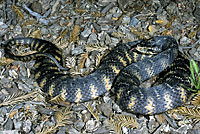 |
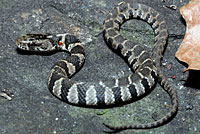 |
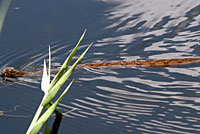 |
||||||
| Adult Florida Watersnake, Sacramento County |
Juvenile Common Watersnake, Lumpkin County, Georgia |
Adult Diamond-backed Watersnake, Hidalgo County, Texas | ||||||
Turtles and Tortoises |
||||||||
| Stray Turtles Don't Always Need to be Rescued | ||||||||
| Box Turtle - Genus Terrapene | ||||||||
| Wild illegally-released or escaped individual box turtles are sometimes found in California, usually in someone's yard. Several species are found in the pet trade. |
||||||||
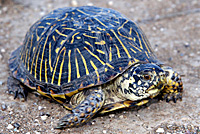 |
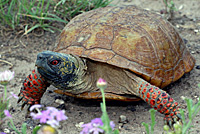 |
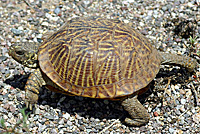 |
||||||
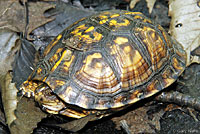 |
 |
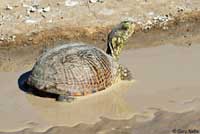 |
||||||
| Pond Sliders - Tracemys scripta | ||||||||
Red-eared Sliders - Trachemys scripta elegans |
||||||||
| These are so common that they are probably the turtle you are most likely to see in California waters. They are established and breeding, but they are also still available in the pet trade, and certainly, more and more of them are released every year when they get too big for their owners to take care of them. I have also received reports of escaped pets wandering in suburban areas. There are many other species of pet turtles that have been released in the state, including a number of Asian species, but turtles are difficult to approach to correctly identify and photograph. I will add more as I discover them. |
||||||||
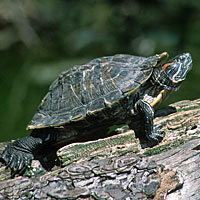 |
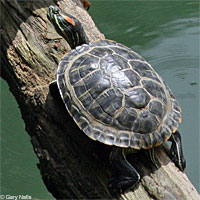 |
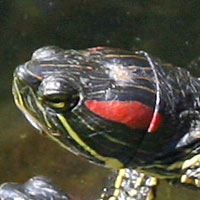 |
||||||
| Adults from California and Texas | ||||||||
| Other kinds of Pond Sliders kept as pets are sometimes found in the wild, but no established populations are known so far. | ||||||||
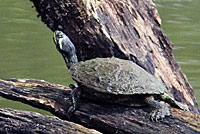 |
 |
|||||||
| Yellow-bellied Slider - Trachemys scripta scripta | ||||||||
| Painted Turtles - Chrysemys picta | ||||||||
| Several kinds of painted turtles are also popular pet turtles that are sometimes found in the wild along with the well-established non-native Western Painted Turtle - Chrysemys picta bellii. |
||||||||
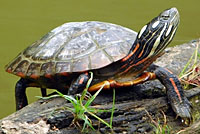 |
||||||||
| Eastern Painted Turtle - Chrysemys picta picta |
||||||||
Mohave Desert Tortoise - Gopherus agassizii |
||||||||
| Desert Tortoises were once very common pets, back when you could go out to the desert, pick one up, and take it home. I've talked to people who used to keep them and let them roam around inside the house. Some of these tortoises were released into the wild when they were no longer wanted, probably because they live so long - 50 to 80 years, according to one source. There is even an established population of Desert Tortoises living in Anza-Borrego State Park, outside of their native range. They became establised as the result of the intentional release of tortoises in the late 1960s, according to an unverified source. |
||||||||
 |
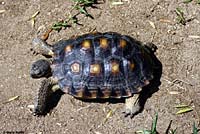 |
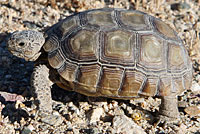 |
||||||
| Adults from California | ||||||||
| Texas Tortoise - Gopherus berlandieri | ||||||||
| Native to southern Texas and northeastern Mexico. Once sold in pet shops, maybe they still are. Owners sometimes released them into the desert when they no longer wanted them. |
||||||||
 |
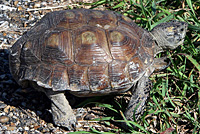 |
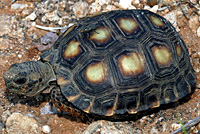 |
||||||
| Adults from Texas | ||||||||
| African Spurred Tortoise - Centrochelys sulcata (also called African Spur Thigh Tortoise or Sulcata Tortoise) |
||||||||
| Kept as pets, sometimes found in the wild after they escape. One was reported to me after it was found swimming in a lake, even though this tortoise is not usually aquatic. |
||||||||
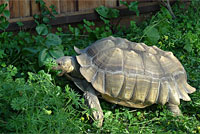 |
||||||||
| This tortoiese was found in a yard in Santa Cruz. |
||||||||
| Leopard Tortoise - Geochelone pardalis | ||||||||
| Kept as pets and sometimes found in the wild. Once reported to be established at Mission Trails park in San Diego County. | ||||||||
 |
||||||||
| Juvenile, Africa | ||||||||
| Alligator Snapping Turtle - Macrochelys temmincki | ||||||||
| This species of snapping turtle is different from the Snapping Turtle - Chelydra serpentina, which has been established in California. |
||||||||
Map Turtles - genus Graptemys |
||||||||
| Several species are common in the pet trade. Sometimes found released into the wild. Map turtles are small turtles with a raised ridge or keel on the middle of the top of the shell. |
||||||||
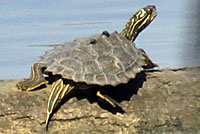 |
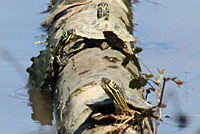 |
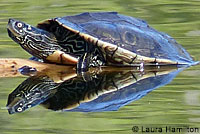 |
||||||
| Map turtles photographed in Alabama | Adult found in a California pond © Laura Hamilton |
|||||||
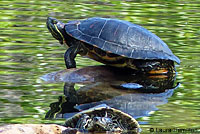 |
||||||||
| Adult map turtle on bottom, Red-eared Slider on top. © Laura Hamilton | ||||||||
| Malaclemys terrapin - Diamondback Terrapin | ||||||||
| Diamond-backed Terrapins are popular in the pet trade, so abandoned pets show up sometimes in California waters. |
||||||||
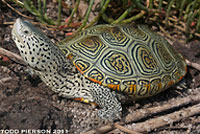 © 2011 Todd Pierson © 2011 Todd Pierson |
||||||||
Frogs and Toads |
||||||||
| Fire-bellied Toad - genus Bombina | ||||||||
| I have received a few requests from people who have found this Asian toad in their yard to identify the species for them. This toad is commonly sold in pet stores, and is a popular pet. |
||||||||
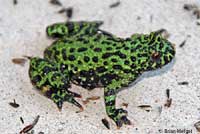 |
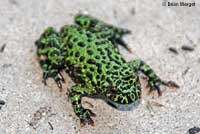 |
|||||||
| © Brian Merget | ||||||||
| Osteopilus septentrionalis - Cuban Treefrog | ||||||||
| This species is one of the treefrog species sometimes kept as a pet. There are a few records of them found in California which were probably escaped pets, but they have also been found on nursery plants which may have been imported from nurseries in Florida where this frog is an established invasive species. The transportation of Cuban Treefrogs and their eggs on nursery plants is a possible method of introduction of this species into the state, though it is not known if they can survive in the dryer, less humid environment. In October 2020 I found three iNaturalist records for this species in Califonria - in Fresno, Ramona, and San Diego. |
||||||||
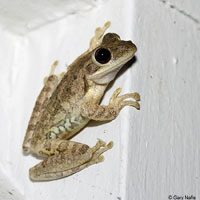 |
 |
 |
||||||
| Hymenochirus boettgeri - Zaire Dwarf Frog (Congo Dwarf Clawed Frog - Dwarf African Clawed Frog) | ||||||||
This frog from tropical Africa, common in the pet trade and often sold under the name African Dwarf Frog, has been found in the San Diego River but it is not known if there is an established population there or if the frog is just a solitary released pet. |
||||||||
Salamanders |
||||||||
| Fire-bellied Newt - genus Cynops | ||||||||
| A couple of species are common in the pet trade: Cynops orientalis - Chinese Fire-bellied Newt Cynops pyrrhogaster - Japanese Fire-bellied Newt I have seen a report that this species has been released into the wild in southern California where it has been established, but could get no confirmation. It has also been found in Golden Gate Park in San Francisco and in a regional park in Contra Costa County in the East Bay, but I don't know if the newts found in those places represent part of a breeding population or individual waifs. |
||||||||
 |
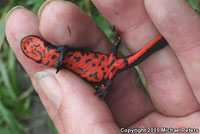 |
|||||||
| © Michael Peters | ||||||||
Crocodilians |
||||||||
| American Alligator - Alligator mississippiensis | ||||||||
| Every once in a while the media gets excited about an alligator found in a local pond or lake as if they were some kind of dangerous monsters. Juveniles were once kept as pets, but as they grew large, they were often dumped into a local lake. Some of them survive for a while until they are removed. Reggie, an alligator that once inhabited Lake Machado in Harbor City, L.A. County, before it was finally captured and sent to the L.A. Zoo in 2007, even has his own Wikipedia Page. |
||||||||
 |
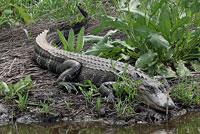 |
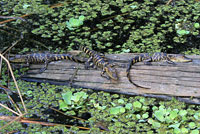 |
||||||
| Adult, Florida | Adult, Texas | Juveniles, Florida | ||||||
Native California Species Kept as Pets Sometimes Show Up in the Wild Where They Shouldn't Be Found |
||||||||
 |
 |
|||||||
| This striped morph California Kingsnake was found in a park in Chico, Butte County, not far from where a non-native Corn Snake was found a month later. The striped pattern is not typically found in Butte County. It is more typical of snakes found near the coast in San Diego County. Therefore I assume that this, like the Corn Snake, was an abandoned pet, probably one bred in captivity. © Kurt Geiger | The Mohave Desert Tortoise was once a popular pet native species. There is a population of them that was intentionally established in the state, which you can learn more about above. | |||||||
Return to the Top
© 2000 -
